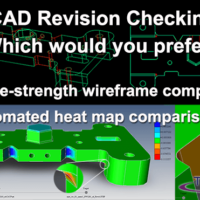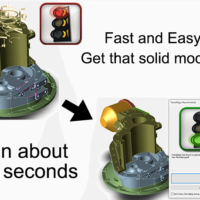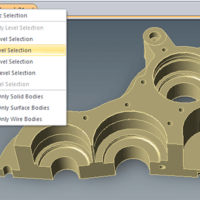
by Brad Strong | Sep 19, 2016 | Blog, CAD Comparison, What's New
When checking customer revisions, if you miss a change, there is the potential to order wrong parts and even manufacture wrong parts. I sometimes ask TransMagic users how often their customers make changes that are undocumented; one said “oh, about 85% of the time”; another said “7 out of 10 times”. Apparently it is not that unusual for the customer to fail to communicate all the changes made at each revision. If estimators of the manufacturing world miss a single customer change they run the risk of: Misquoting the part, thereby potentially charging too little for the tooling they create Creating the wrong tooling, thereby wasting time...

by Brad Strong | Sep 7, 2016 | Blog, CAD Repair, CAD Translation, Support, What's New
Imagine that you have a part or assembly that is difficult to repair; what you’re after is a watertight solid. Here’s a classic repair scenario that demonstrates the use of different selection modes in the context of a repair situation. The main purpose of this process is to delete any construction or ‘scrap’ geometry that may be interfering with the repair process; such ‘scrap’ has been artificially created for this example, but it’s common enough in real-world examples. TransMagic has other techniques and tools, but this is one of the more common and effective. We’ve broken this process down into ten steps,...

by Brad Strong | Aug 29, 2016 | Blog, CAD Repair, CAD Translation, Support, What's New
Choosing Your Selection Options At first glance, it looks as if there are only four geometry selection options in TransMagic – Single Select, denoted by an arrow, Window Select, denoted by a rectangle, Select All Entities and Deselect All Entities (see screenshot at right). However, there is a drop down arrow to the right of the top two buttons, which allows you to filter out entities. Selection filters can be applied in the following ways. Dynamic Selection Assembly Level Selection Body Level Selection Face Level Selection Edge Level Selection Vertex Level Selection PMI Level Selection Select Only Solid Bodies Select Only Surface Bodies Select Only Wire...

by Brad Strong | Aug 25, 2016 | Blog, CAD Comparison, CAD Performance, CAD Translation, What's New
In Six Reasons to Avoid IGES Files, we made the case that IGES, at 20 years old, is no longer an optimal format for manufacturing. In this article we’ll look at three categories of format that have proven success in manufacturing. The best alternatives to IGES, in order of preference: #1 – Go Native There is often a reasonable bridge to be found between the format you’ve been given and the CAD system you need to bring it into. The best possible workflow is to get the native file from your customer or supplier, open it in your CAD system and make the necessary edits, and then give it back to the customer or supplier in their native format again. For...

by Brad Strong | Aug 23, 2016 | Blog, CAD Performance, CAD Repair, CAD Translation, What's New |
The IGES file has been the bane of the CAD/CAM/CAE world for years, yet it remains with us to this day. This article defines some of the problems with the IGES format. A follow-up article will propose some alternative formats which are better equipped to handle most 3D design data needs. IGES stands for Initial Graphics Exchange Specification; it was first published in 1980 as a vendor-neutral file format to facilitate the transfer of information among different CAD systems, and though use has dropped in the last decade, IGES is still a widely used format in the manufacturing world. In fact, the 2013 3D Collaboration and Interoperability Report published by...

by Brad Strong | Aug 16, 2016 | Blog, CAD Performance, CAD Translation, What's New
Taking the time to optimize and save your settings can make a huge difference in performance; they can determine how much work is necessary on a part or assembly, whether you are working in inches or millimeters, how fast files will open (based on whether you are running repair upon load or not), whether edges or vertices are included in the translation process, how hidden or suppressed geometry is dealt with, whether JT files will be considered as Visrep or Visrep + Brep, and much more. This article will discuss some of the most important of these settings, and demonstrate how you can save your TransMagic settings individually, as a department or as a...







